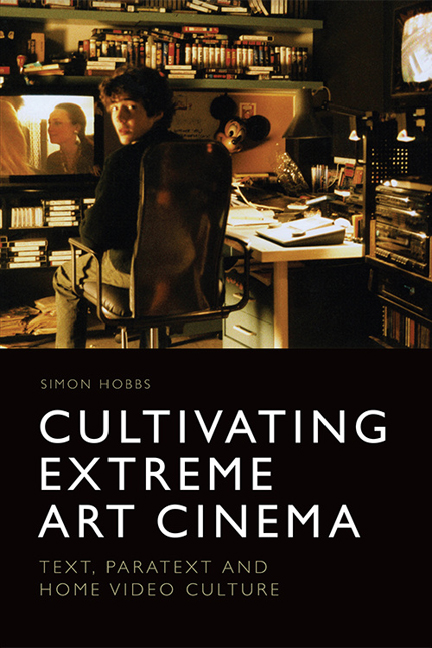Book contents
- Frontmatter
- Contents
- List of Figures
- Acknowledgements
- 1 Introduction
- 2 Art and Exploitation: Crossover, Slippage and Fluidity
- 3 Early Extremity on DVD: History, Precursors and Exploitation Auteurs
- 4 Weekend and Cannibal Holocaust: Art, Ballyhoo and Remediation
- 5 Salò, Or the 120 Days of Sodom and Ilsa, the Wicked Warden: Fascism, Pornography and Disgust
- 6 Contemporary Extremity on DVD: Trends, Hard-core and Geographic Mobility
- 7 Michael Haneke: Glaciation, Legitimacy and Transgression
- 8 Lars von Trier: Provocation, Condemnation and Confrontation
- 9 Conclusion
- Bibliography
- Index
9 - Conclusion
Published online by Cambridge University Press: 28 April 2021
- Frontmatter
- Contents
- List of Figures
- Acknowledgements
- 1 Introduction
- 2 Art and Exploitation: Crossover, Slippage and Fluidity
- 3 Early Extremity on DVD: History, Precursors and Exploitation Auteurs
- 4 Weekend and Cannibal Holocaust: Art, Ballyhoo and Remediation
- 5 Salò, Or the 120 Days of Sodom and Ilsa, the Wicked Warden: Fascism, Pornography and Disgust
- 6 Contemporary Extremity on DVD: Trends, Hard-core and Geographic Mobility
- 7 Michael Haneke: Glaciation, Legitimacy and Transgression
- 8 Lars von Trier: Provocation, Condemnation and Confrontation
- 9 Conclusion
- Bibliography
- Index
Summary
By investigating the tangible commercial object, my work has offered a more comprehensive extreme art continuum then those studies that have been constrained by historical and geographical restrictions. Seeking to reflect on the discoveries of this analysis, this conclusion will address the limitations of the book's Eurocentric focus, isolate several reoccurring trends which typify the paratextual portrayal of extreme art cinema, and explore the changing status of the DVD and Blu-ray market following the rapid advancement of digital streaming.
New Movements in Extreme Art Cinema
As has been discussed throughout this book, extreme art film has often been regarded as ‘new’, with terms such as ‘new brutalism’ (Austin 2008: 114) and ‘the New French Extremity’ (Quandt 2004: 127; Hagman 2007: 37) limiting the ways scholars read both historical and contemporary examples of cinematic transgression. Through the implementation of a more historically mobile pan-European lens, this book has begun to readdress these boundaries. My work has drawn attention to the ways art and exploitation cinema are informed by the hybridisation of ‘highbrow’ and ‘lowbrow’ traditions, allowing for the often isolated contemporary extreme works to be more readily assimilated into a longstanding history of cultural crossover. The meeting of these two sites is characterised by communal portrayals of a sexualised or violently deconstructed body and the implementation (either intentionally or accidentally) of experimental visual registers which challenge the audience's passivity. By using this as a backdrop for a paratextual study of the extreme art film object, this work has drawn together a series of under-explored films (at least within a context of extreme cinema) from different historical, national and cultural contexts.
Yet even though this history of exchange and slippage is fundamental to charting the development and sustained relevance of the extreme art film tradition, the majority of art and exploitation narratives fall outside of this collision point. It was never the intention of this work to suggest that all art films portray extreme violence or sexual content, or equally that all exploitation narratives illustrate self-reflexivity, a counter-aesthetic or intellectual engagement. Indeed, the taboo art films of Pedro Almodóvar, or the visually excessive texts of the Cinéma du Look, lack the visceral extremity of their extreme art cinema peers. Likewise, there are many exploitation narratives that actively oppose the use of challenging narratives and experimental visuals due to the way they impact the product's commerciality.
- Type
- Chapter
- Information
- Cultivating Extreme Art CinemaText, Paratext and Home Video Culture, pp. 189 - 203Publisher: Edinburgh University PressPrint publication year: 2018



